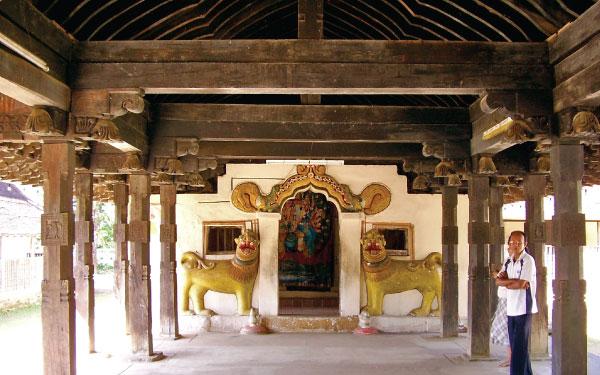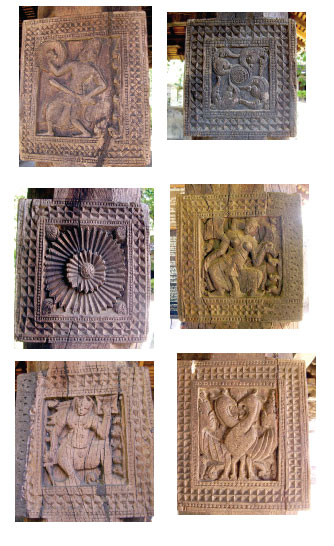
Embekke Devale, nestled in Udu Nuwara, lies close to Daulagala, about eight miles from Kandy.
The Embekke Devale is the finest example of Sri Lankan architecture and art showcased in wood. Almost every inch of the wooden structure is decorated with elaborated, intricate carvings on rafters, beam columns, bracket, doorways, doors and windows. Nothing was spared.
The devale
The devale is a deistic shrine with magnificent wooden architectural elegance belonging to the 14th century. A notice at the entrance to the devale explains the history of the devale. It was an audience hall of the Gampola kings, originally built in the 14th century and later dedicated to the God of Kataragama.
The carvings include 125 series of decorations, 256 liyawel, 64 lotus designs on Pekada (brackets), and 30 decorative patterns on timber roof beams, making a total of 514 fabulous carvings.
My favourite masterpieces on these amazing wooden pillars include the Hansa Puttuwa (entwined swans) two-headed eagles, and interwoven rope designs, the soldier fighting on horseback, female dancing figures, wrestlers, elephant-bull combination and the elephant-lion fusion.
Drummers Hall
The building on the temple ground called the Drummers Hall has some of the most intricate carvings on the columns. Some carvings at the entrance to the Hall, known as the Vahalkada, are some of the best examples of Sinhalese art in Sri Lanka. Some ancient stories claim that some of the beautiful woodwork in the Drummers Hall was originally in the abandoned Royal Audience Hall in Gampola.
The roof of the Drummers Hall has significant features. The rafters all slant from above towards the middle and are fixed together and kept in position by a Madol Kurupawa, a kind of a giant catch pin, which holds together 26 rafters at the hipped end of the roof of the Digge of the Embekke Devale. The Madol Kurupawa is one of the finest examples of medieval carpentry excellence. This kind of spectacular architecture is very rare.
The doors to the sanctum from the open-side of the hall are heavy wooden beams without nails or hinges. Instead they pivot on adjoining building has a cell in which the sole occupant is a magnificent peacock on a pedestal. It was carved from a single piece of wood. There is a small shrine in the corner of the building which has a Buddha statue belonging to the Kandyan style with a decorated wooden door.
Ancient documents
According to ancient documents and the epic Embekke Varnanawa, the devale was built during the Gampola period of King Vickramabahu III (1371 AD). The story goes that one of the king’s beautiful consorts, Henakanda Biso Bandara, in collaboration with a drummer named Rangama, had a miraculous dream in which he built this devale dedicated to the deity Kataragama in a three-storeyed building that is now non-existent. The devale was built in two segmented buildings, the Digge (Dancing Hall) and Drummers Hall (Hewasi Mandappaya).
The odd-looking building at the other side of the devale that is suspended a foot above the ground on huge wooden beams set on stone pillars, is an ancient vee-atuwa, or paddy container. The twin rooms with white-washed walls have neither doors nor windows, only an entrance hole. Sacks of rice are stuffed through the holes to be stored and can only be retrieved by a man small enough to climb through the narrow openings.
Most visitors miss the ruins of the Embekke Ambalama, a royal shelter. This Ambalama, is situated close to the devale in a paddy field. The location of the site is not difficult. In the days of king Buwanekabahu IV of Gampola this Ambalama had been constructed to serve as a resting place for those involved in the construction of the temples at Gadaladeniya and Lankathilaka.
It has been built on a rock boulder. About 20 stone pillars seven feet in height have been erected on the rock and each column contains stone carvings similar to wood carvings at the devale.
